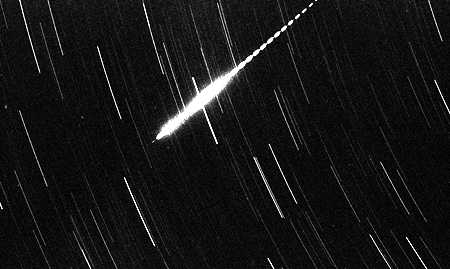
Photo from nineplanets.org
The journey of the meteoroid becomes less simple once they get close enough to a planet to hit the atmosphere.
Once the meteoroid gets into the atmosphere, the meteoroid rapidly compresses the air and gases around it.
This event is called ram pressure. The compression of the gases heats up the air, which heats up the meteor at over 1921.9K.
The ram pressure depends primarily on the entering velocity.
This intense increase in temperature burns up the meteor, depending on its size, and leaves a trail of dust behind.
Since most meteoroids are small, most of them completely burn up while in the atmosphere and never become meteorites.
So we know what's going on in the upper atmosphere with the meteors. But what about what we're seeing?
From below, all we see of the meteor is a luminous glow and a trail from the particles that are coming off.
The luminosity of the meteor is dependent on the size of the meteoroid.
Most of the "shooting stars" people see are basically find particles going through the atmosphere.
Anything the size of a pebble or larger creates a fireball--basically a larger meteor that glows brighter.
The intensity of the glow (I) is given by: I=P/A, where P=power=energy/time and area=area of meteoroid.
The intensity in this case is often referred to as the apparent magnitude, where the lower magnitude is brighter.
The apparent magnitude is denoted by m#, and the equation for two different magnitudes is:
m1-m2=2.5log(b2/b1, where b is the brightness.
So fireballs have lower magnitude than normal meteors.